本文
The world of the Aonogahara Prisoner of War Camp
Prisoners were transferred to the Aonogahara Prisoner of War Camp in September 1915, and the prisoners who remained at the internment camp to the very end even after the armistice of World War I (October 1918) and the signing of the peace treaty (June and September 1919) set out for home in January 1920. In other words, some German and Austro-Hungarian soldiers spent as long as four years and four months at the Aonogahara Prisoner of War Camp. What was their life like at the camp? The world of the Aonogahara Prisoner of War Camp is described in a diary left by Herrman Kersten (German Navy second-class artilleryman) (hereinafter referred to as “Kersten’s Diary”), and photos left by Heinrich Hangstein (radio operator for the Government-General), both of whom were interned at the camp.
The Aonogahara Prisoner of War Camp had three barracks for the prisoners, a barrack for officers, a barrack used for a general office and the doctor’s office, a barrack used for a kitchen and a bathroom, and a post exchange. Almost 500 prisoners lived in these barracks, and about 40 security guards and 15 police officers kept watch on them. They were put under certain restrictions, such as mandatory morning and evening roll calls, inspections of personal belongings and a limit of 30 yen in cash. Otherwise, the prisoners were granted relative freedom.
The following are the plot plans of the Aonogahara Prisoner of War Camp, reproduced by Koji Ose of the Kobe Architecture and Cultural Property Institute based on materials related to the internment camp, such as Kersten’s Diary, a panoramic view of the Aonogahara Prisoner of War Camp drawn by W. Tegge and photographs, as well as postwar materials, such as an aerial photo taken in 1946, materials on the surveys of historical structures conducted by Kasai City in 2002 and 2005 and the topographical map of Kasai City.
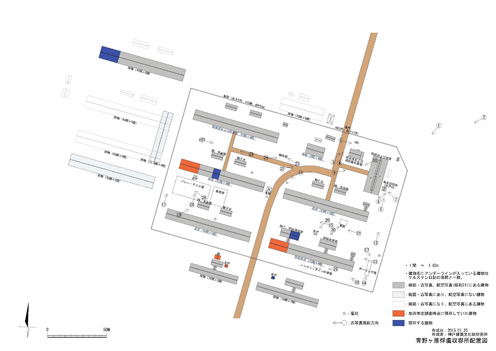
Map: The plot plan of the Aonogahara Prisoner of War Camp (drawn up by Koji Ose)
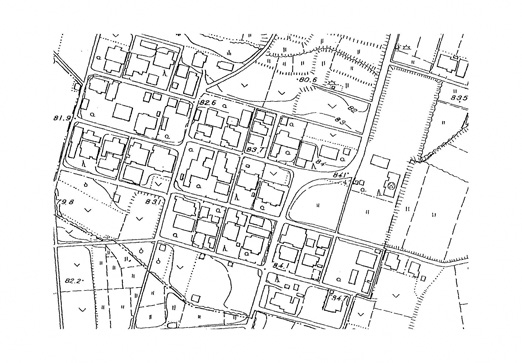
Map: The topographical map of Kasai City (present)

Map: A topographical map with the plot plan of the Aonogahara Prisoner of War Camp superimposed (drawn up by Koji Ose)

Map: An aerial photo taken in 1946(Collection of Geospatial Information Authority of Japan)

Map: An aerial photo with the plot plan of the Aonogahara Prisoner of War Camp superimposed (drawn up by Koji Ose)

Photo: The exterior of the Aonogahara Prisoner of War Camp (1) (courtesy of Mr. Hans Joachim Schmidt)
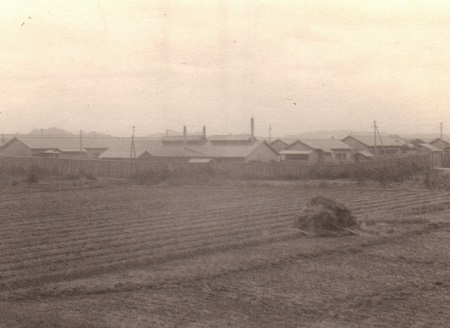
Photo: The exterior of the Aonogahara Prisoner of War Camp (2) (from the prisoners’ book of photos) (courtesy of the Naruto German House)

Photo: The front gate of the Aonogahara Prisoner of War Camp (3) (courtesy of by Mr. Dieter Linke)
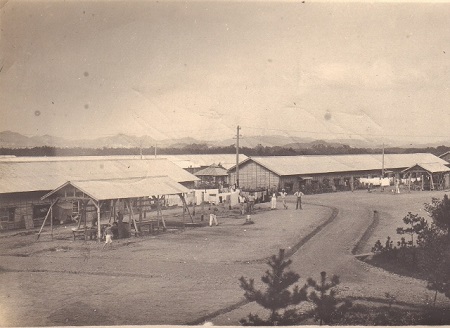
Photo: The inside of the Aonogahara Prisoner of War Camp (10) (courtesy of Mr. Hans Joachim Schmidt)

Photo: Barracks with futons aired out on the rooftops (16) (courtesy of Mr. Dieter Linke)
This photo shows futons aired out on the rooftops of the barracks. Regarding this, Kersten wrote in his diary, “When influenza raged in 1918, some prisoners were affected. By working hard to air out futons from morning to evening, none of us died, although some of us became ill.” It is said that the death toll of the Spanish Influenza pandemic of 1918–1919 was 50 to 100 million people worldwide and 1.48 million people died in Japan as well.
Barracks
About 60 prisoners lived under the same roof in the barracks used for soldiers. According to Kersten’s Diary, two 27-meter boarded beds were placed in the barracks with six tables and benches and two coal stoves placed in between them. The sleeping space for each prisoner was 90 centimeters wide.

Image: A reconstruction of a barrack for soldiers (drawn up by Koji Ose)

Photo: The inside of a barrack (courtesy of Mr. Dieter Linke)

Image: A reconstruction of a barrack for officers (drawn up by Koji Ose)

Photo: The inside of a barrack for officers (from the prisoners’ book of photos) (courtesy of the Naruto German House)
Post exchange
The post exchange sold alcoholic beverages. It can be seen in the photo that the emblem on the beer is Asahi Beer (Dai Nippon Breweries, Co., Ltd.). In addition, Mitsuya Champagne Cider (currently Mitsuya Cider) (Imperial Mineral Water Co., Ltd.) is also seen on the counter.
Imperial Mineral Water Co., Ltd. merged with Dai Nippon Breweries, Co., Ltd. in 1933. By a curious twist of fate, the two brands displayed at the post exchange of a prisoner of war camp would merge into one company about 15 years later. This can be considered a precious scene in the history of Japanese drinking water.

Photo: A post exchange (courtesy of Mr. Hans Joachim Schmidt)

Photo: Mitsuya Champagne Cider (leftmost) and Asahi Beer (rightmost) in the Taisho period (1912–1926) (courtesy of Asahi Group Holdings, Ltd.)
In addition, on the signboard at the back is written, “Hirano Wasser” in German. This shows that Imperial Mineral Water conducted wholesale marketing in those days and even produced goods for sales promotion.
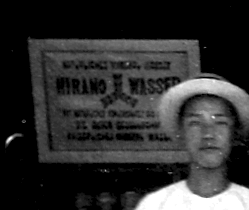
Image: A signboard for cider was enlarged from the above-mentioned photo of the post exchange.









